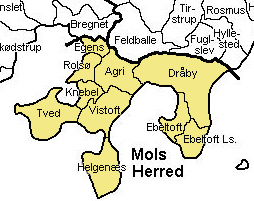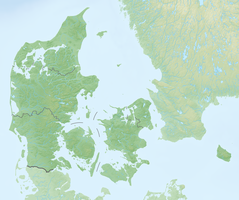Mols (Denmark)
| Mols, Denmark | ||
 View from Ellemandsbjerg |
||
| Geographical location | ||
|
|
||
| Coordinates | 56 ° 15 ′ 0 ″ N , 10 ° 36 ′ 0 ″ E | |
| Waters 1 | Aarhus Bugt | |
 |
||
Mols is a peninsula and landscape on the east coast of Jutland in the southern part of the Djursland peninsula , part of the Cimbrian Peninsula in Denmark .
The Ebeltoft peninsula and the Helgenæs are also commonly referred to by this name, but more precisely, it is only the area between the bays Kalø Vig and Ebeltoft Vig that protrudes into the Aarhus Bugt .
The landscape on Mols was created 12,000 years ago at the end of the last ice age . The ice on Jutland had almost melted when two tongues of ice slid over Mols as a result of another cold snap. The glaciers left behind a chain of hills of sand and gravel, today's Mols Bjerge in the Mols Bjerge National Park . The hilly area between Knebel and Fuglsø in the south, Agri (pronounced Auri) in the middle and Femmøller (five mills) in the north, is one of the most magnificent moraine landscapes in the country, reaching a height of 137 m in the Agri Bavnehøj hill . Larger lumps of ice remained and only melted slowly. This so-called dead ice formed dead ice holes with steep slopes.
Attractions
In gag on the circular gag Vig is poskær stenhus , one of the most barrows of Denmark in a round stone setting . In the Tinghulen ( Thing Gorge) east of Knebel used to be the Thingplatz of the area.
The Mols Bjerge National Park is a 180 km² protected area and includes large areas of forest, heather and grassland as well as lakes and coastal areas.
history
At the isthmus of Dragsmur , which connects Helgenæs with Mols, entrenchments were built during the German-Danish War (1848–1850) . The Danish troops were disembarked from this reception position on Helgenæs in 1849 and used in the Battle of Fredericia in which General Olaf Rye fell. Before that, they had been driven to the peninsula by the Prussian army under the leadership of Olaf Rye (1791–1849) .
According to legend, sacrifices were made to the Nordic gods on the 99 m high Ellemandsbjerg .
In the vicinity of the Mols peninsula are:
- the city of Ebeltoft
- the island of Kalø, accessible via a narrow dam, with the restored ruins of the royal castle ( Kalø Slotsruin ) (built from 1313), in which Gustav Vasa was imprisoned in 1518 .
- the only round church in Jutland from around 1200 , the Thorsager Church .
- the Kolindsund
Bay at Ebeltoft
traffic
- Ferry connection from Ebeltoft to Odden Færgehavn ( Zealand )
- The airport of Aarhus (Aarhus Lufthavn) near Tirstrup is a few minutes away by car.
Web links
- Mols region portal (Danish)
- The Helgenæs
Individual evidence
- ↑ Mols. The Danske store , accessed March 4, 2014 .






